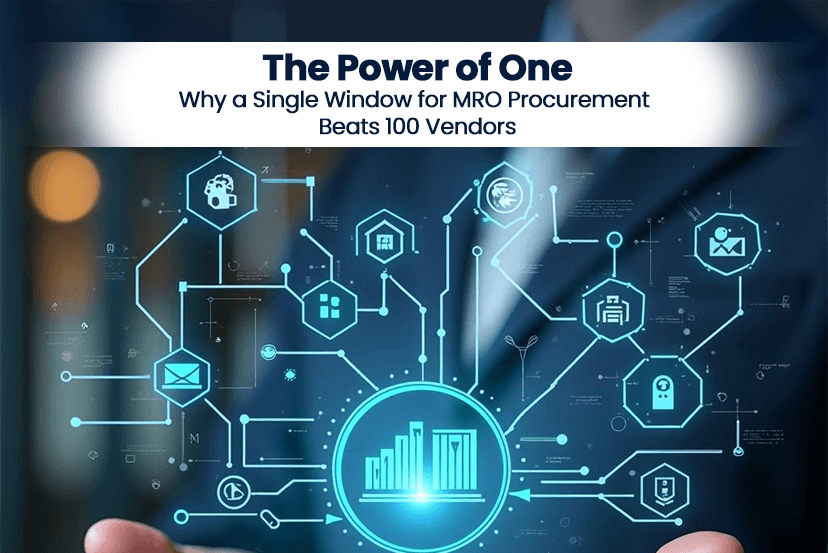The Power of One: Why a Single Window for MRO Procurement Beats 100 Vendors

Still Managing 100 MRO Vendors? There’s a Better Way.
Let’s be real-Maintenance, Repair, and Operations (MRO) procurement has a habit of getting messy fast.
It starts simple. You need a few spares, a few tools, and a few suppliers. But fast forward a year, and suddenly you’ve got 78 vendor codes, 4 different quote formats, and a spreadsheet that no one wants to touch.
Sound familiar?
That’s why more companies are rethinking the entire approach-ditching the vendor jungle and moving to a single-window MRO procurement model. Less admin. More control. Lower total cost. And a supply chain that doesn’t make your ops team want to scream.
Let’s break down what’s actually changing-and why consolidating MRO just makes sense right now.
Why Juggling Vendors Doesn’t Work Anymore
There was a time when spreading your MRO spend across 10, 20, even 100 vendors felt like a good strategy. You’d compare prices, negotiate better deals, and avoid dependency on any one supplier.
But here’s the thing: that logic falls apart when you factor in everything else.
Multiple vendors mean:
- More POs, more follow-ups, more chasing
- Disconnected data across categories
- Zero visibility into total spend or savings
- Wildly inconsistent lead times
- Overlapping SKUs with different specs
And the real kicker? The “cost savings” from sourcing everything piecemeal usually disappear once you add up the hidden costs: delayed maintenance, downtime, overstocking, urgent shipping fees, you get the idea.
What a Single-Window Model Actually Looks Like
A single-window MRO procurement model doesn’t mean you’re buying less. It means you’re buying smarter through one trusted partner who manages the complexity for you.
Here’s what it looks like in action:
- One partner manages sourcing across multiple categories
- A unified catalog with pre-vetted SKUs and suppliers
- Centralized tracking, billing, and reporting
- Fewer touchpoints, cleaner communication
- Built-in compliance with your quality and sourcing policies
You still get access to multiple brands, product options, and price points—just without the chaos of dealing with 30+ vendors every month.
The Payoff: Why More Companies Are Consolidating Now
1. Lower Total Cost of Ownership (TCO)
Sure, the unit price might be 2% lower from Vendor X. But when you factor in freight, admin, downtime, and duplicate inventory? The “cheaper” option often ends up costing you more.
Single-window models help optimize the entire MRO lifecycle-from sourcing to stocking to invoicing. That’s where the real savings are.
2. Faster Turnaround, Fewer Stockouts
Working with one partner means faster sourcing, quicker issue resolution, and better planning. You get clearer visibility into stock levels, lead times, and reorder points, so maintenance never gets held up because someone forgot to order bearings last week.
3. Streamlined Workflows (That People Actually Use)
No more chasing five vendors for five quotes. No more mismatched part numbers or surprise substitutions. A single-window system standardizes the entire workflow, so your teams can focus on what matters-keeping operations running smoothly.
4. Better Negotiation Power
When you consolidate spend with one partner, you gain leverage. That leads to better rates, stronger SLAs, and actual service guarantees. You’re not just another small order in someone’s inbox-you’re a strategic customer.
5. Real Data, Real Decisions
When all your MRO procurement runs through one source, suddenly you can see things clearly. Which plants are over-ordering? Where is the bleeding margin? What’s the actual cost of maintaining that legacy machine?
You can’t fix what you can’t see. Single-window models give you the data to make smarter calls, faster.
What This Looks Like on the Ground
Let’s say you’re running multiple facilities across regions. Each site has its own vendor list, preferred brands, and procurement process. Sounds flexible-but in practice?
- You’re duplicating efforts at every site
- You’re missing out on volume discounts
- Stockouts and urgent buys are happening too often
- There’s no clean way to compare or track spend across the network
Now picture this instead:
- All MRO procurement flows through one central partner
- SKUs are standardized where possible
- You get consolidated billing and real-time dashboards
- Each facility still has autonomy-just within a smarter, unified system
Suddenly, you’re not just keeping up. You’re running leaner, faster, and more predictably.
A Few Things to Watch Out For
Going from 100 vendors to one isn’t about locking yourself in. It’s about building a relationship with a partner who can flex with you.
That means:
- Transparent pricing
- A strong vendor network behind the scenes
- Custom catalog options for your specific needs
- SLAs that actually reflect your ops schedule
- Ongoing support-not just another helpdesk ticket
You want a partner, not a gatekeeper.
Final Thoughts: Less Chaos, More Control
The old model of managing a long list of MRO vendors is showing its cracks. It eats up time, bloats your costs, and keeps your teams in reactive mode.
Switching to a single-window MRO model at Moglix Business not only cleans up the mess but also gives you control, consistency, and clarity where it matters most.
And here’s the best part: it doesn’t mean giving up flexibility. It means being intentional about how you buy, who you partner with, and how your systems support your business-not slow it down.
